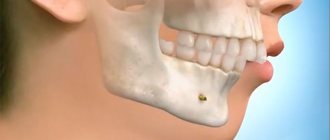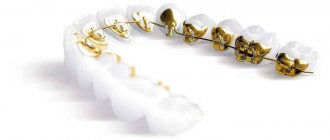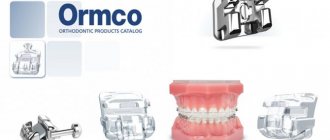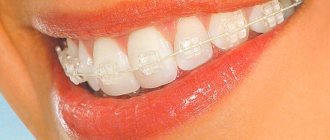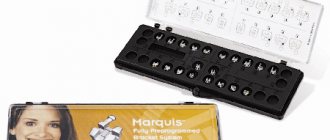After the orthodontist installs ligature braces, the patient will have to systematically visit the dental clinic to adjust the position of the ligatures and replace the arches. If you choose self-ligating models, you can reduce the number of visits to your doctor to once every 2-3 months. This will save time and financial resources.
To understand whether such a system is suitable in each specific case, it is necessary to understand what its advantages and disadvantages are, what the design features are, and how the process of installing and removing the product occurs.
Excursion into history
At the beginning of the 20th century, the American doctor Edward Engle created the first prototype of the braces system and called it the Engle apparatus. Angle's apparatus consisted of an elastic stainless steel arc and ligature elements. The arc was tightly fixed in the tubes. The tubes were soldered to orthodontic rings placed on the first molars. Each tooth was tied to an arch curved in the shape of the dentition with a ligature wire.
Subsequently, the scientist significantly changed the original design and developed the edgewise technique. Orthodontic locks, edgewise, were a rectangular piece with a groove. An arc was inserted into the groove and the lock was locked with a pin. Subsequently, the design of braces was modified: orthodontic arches with a square and rectangular cross-section profile, with sharp and rounded edges, appeared.
Later, the edgewise technique was further modified by doctors. Thanks to the active development of orthodontics in the 20th century, the modern operating principle of braces was formed. Today, the doctor is offered various options for torque and angulation. Torque (or inclination) is the deviation of a tooth from its axis in the vestibulo-oral direction. Angulation is the deviation of the tooth in the mesio-distal direction. Taking into account torque and angulation allows, based on a specific clinical case, to individually select the optimal brace option for each tooth.
Aesthetic system without ligatures - what is it?
It is widely believed that non-ligature braces are a type of aesthetic system. In fact, this is only partly true.
Aesthetic self-ligating braces include ceramic and sapphire designs. Metal ones, although they look more attractive than ligature systems due to small locks, can hardly be called aesthetic. They look neat, but are much more noticeable than designs made of ceramics and artificial sapphires.
Also, aesthetic non-ligature braces include lingual systems - they are attached to the “lingual”, inner surface of the teeth. Such designs are invisible and are often chosen by public people.
The only drawback of non-ligature aesthetic systems is their high price. In order to reduce it, dentists combine materials: in the frontal zone, sapphire or ceramic clasps are fixed on the upper teeth, and metal ones on the lower jaw, chewing teeth.
Construction of braces: comparison of non-ligating and self-ligating structures
There are ligature and self-ligating devices. The first includes traditional designs: the arc is fixed in the groove using elastic or wire ligatures. Example: Mini Diamond, Inspire Ice, Orthos devices. Ligature systems are characterized by a long treatment period - from one to three years, depending on the complexity of the clinical case, lengthy adaptation and labor-intensive hygienic care. Activate the device: replace arches and ligatures, it is necessary on average once a month, and sometimes more often.
traditional construction with ligatures
ligature Mini Diamond
The design of self-ligating braces has a fundamental difference: the system works without ligatures. Consists of a groove and a closing lid. The orthodontic arch slides in the groove. Ligature-free designs provide a reduction in treatment time compared to ligature devices by an average of 7 months. Less painful during the adaptation stage and easier from the point of view of oral hygiene. They turn out to be the option of choice in many clinical cases. The entire line of Damon System braces are self-ligating.
self-ligating Damon Q2
How does a braces system without ligatures work? The principle of operation of non-ligation devices is divided into passive and active self-ligation. With the passive type of fixation, the arc moves freely in the groove. The cover holds the arc and does not put pressure on it. Example: Damon Q, Damon Clear. With the active type of self-ligation, the clip presses on the arch and moves it to the base of the groove. Activation of self-ligating systems is carried out once every 2-3 months.
system without ligatures
Damon Clear and Q on typodont
Braces are made from various materials. Ligature and self-ligating structures are made of metal, transparent polycrystalline aluminum (ceramics), plastic and artificially grown sapphire. Metal braces, for example, Damon Q and Damon 3 MX, are the most durable. The Damon Clear2 ceramic and sapphire Inspire Ice models have the best aesthetic characteristics.
metal Damon Q2
ceramic Damon Clear
The orthodontist and the patient jointly overcome the path to high aesthetic smiles and a healthy dental system. Regardless of the type of braces and manufacturing material, the combination of the orthodontist’s professionalism with a high degree of patient responsibility allows one to achieve stable results in the treatment of malocclusions.
Types of self-ligating braces, how they differ
In our clinic, orthodontic treatment is carried out with non-ligated braces ]Forestadent[/anchor] and ORMCO (Damon). These are comfortable, aesthetic and effective devices that allow you to achieve results as quickly as possible.
Metal
Inexpensive corrective devices that cope with even the most complex malocclusions. They are made of medical steel, do not break, and do not require complex care. If the lock comes off, you can glue it back on. The main disadvantage of metal systems is unsatisfactory aesthetics, however, manufacturers offer improved models with small locks with rounded corners.
Ceramic
Aesthetic, matched to the color of tooth enamel, practically invisible. However, treatment with such devices takes longer than with metal ones. Patients should take into account that due to active chewing loads, chips are possible. Ceramic braces are used in patients for whom the aesthetic side is extremely important during the orthodontic course.
Sapphire
The most invisible, due to the high degree of transparency of the material (artificial sapphire). They retain their original properties throughout the course of treatment and are not stained by food coloring. Among the disadvantages of sapphire braces: high price.
Combined
Combined braces are used when it is necessary to combine aesthetics and functionality. Braces made of different materials are installed in different parts of the jaw. For example, in the smile zone there are ceramic ones, and in the side ones there are metal ones. Combination allows you to save on treatment, while achieving results and at the same time maintaining aesthetics.
Biomechanics of tooth movement
To understand how braces work, let’s look at the biological and physiological processes that occur during tooth movement. The teeth are located in the alveoli - natural depressions in the jaw bones of the skull. The root of each tooth is surrounded by periodontal fibers that hold the tooth in the socket. The fibers also perform a shock-absorbing function: they allow the tooth to make micro-movements in all directions. After fixing the bracket and installing the arch, force begins to act on the root of the tooth. To move teeth slowly and less painfully, a weak and prolonged force is applied.
Due to the movement of the tooth root, there is a need to free up space in the alveolus. To do this, osteoclasts begin to destroy the bone where the root touches the alveolar wall. Osteoclasts are special cells that remove bone tissue. On the opposite side, osteoblasts produce new bone to fill the vacated space. Under the influence of osteoclasts and osteoblasts, the balance of formation and destruction of bone tissue ensures the progressive movement of teeth.
Installation of braces
A general understanding of how dental braces work, the design and installation process of the system is important for everyone. There are two installation options: direct and indirect method.
The direct method involves manually installing and positioning each bracket on a tooth directly in the patient’s mouth. Fixation is carried out on a light-curing material. The indirect method involves positioning the system on a plaster model. The braces are transferred from the model to the mouthguard. The mouthguard is formed individually for each patient. Next, glue is applied, the mouthguard is put on the teeth, and the braces are fixed in a predetermined position for each jaw in turn.
Price
The cost of orthodontic treatment depends on the manufacturer and material. Our clinic has promotional offers that provide payment in installments for treatment.
What is included in the cost of the annual course and payment terms:
- diagnostics - free;
- braces + installation - first payment (the amount depends on the type of system);
- corrections, consultations - monthly, fixed payment for all types of braces;
- withdrawal is free.
Stages of treatment
The first stage is preparation for orthodontic treatment. Preparation includes x-ray diagnostics, sanitation of the oral cavity and removal of the required number of teeth.
The second stage involves fixing the structure. An initial thin arch with a round cross-section profile is installed. Further in the treatment process, the doctor changes the arcs from a smaller cross-sectional diameter to a larger one. At the final stages, rectangular rigid arches are used.
On average, it is necessary to visit a doctor from once a month when treating with ligature models to once every 2-2.5 months when treating with self-ligating systems. At the end of the second stage of treatment, the doctor removes the braces using enamel-safe forceps. The remaining adhesive is removed from the surface of the teeth with a low-abrasive bur, and the tooth is polished with a brush using a polishing paste.
The third stage is the retention period. The results of orthodontic treatment are stabilized with the help of permanent retainers and aligners.
The duration of treatment depends on the complexity of the anomaly being corrected, the individual anatomical characteristics of the patient and the professionalism of the orthodontist. The speed of tooth movement is influenced by the design of the brace: self-ligating systems can provide faster results in 1-2 years. Treatment with ligature models lasts on average 2 to 3 years.
Some dental anomalies are corrected using removable hard aligners. When treated with aligners, the patient is given a set of several rigid aligners that differ in shape. The patient changes the aligners independently every two weeks. Once every month and a half, the patient visits the orthodontist to assess the progress of treatment. Mouthguards are worn constantly: the device is removed only when eating and brushing teeth.
The best manufacturers of non-ligature metal bracket systems
- Damon Q. These braces are used if the clinical case is difficult to treat. The system can be configured separately for each person. Moreover, the doctor himself can predict the treatment, and the Damon Q brace system will work in such a way that the result will be obtained in the shortest possible time.
- Damon 3MX. For a long time, this system was considered one of the most advanced non-ligature brace systems. The main advantage of Damon 3MX is that they do not have cutting corners and are thin, which ensures the greatest comfort and addiction;
- Smart Clip. These ligature-free braces have a unique patented official snap mechanism. This mechanism makes it possible to accurately control the arc strength and, if necessary, change it to provide the best effect during the treatment process;
- In-ovation R. This bracket system has a very small size, which allows it to install an arch of almost any size on the brackets. Among other things, the unique design allows you to act on the arch, additionally reducing the time of orthodontic treatment.
Sources used:
- The Angle Orthodontist
- Proffitt U.R., Modern orthodontics (3rd edition), MEDpress-inform, 2015, 560 p.
- British Orthodontic Society
Comparison of lingual and vestibular constructions
Based on their location in the dental cavity, they are divided into lingual and vestibular systems. The vestibular position on the outer side of the dentition is classic and is used in the vast majority of cases.
Vestibular Mini Diamond
Lingual appliances are installed by patients with the highest aesthetic requirements. Adaptation to internal systems is more difficult compared to vestibular structures. The principle of operation of lingual and vestibular braces is not fundamentally different: in both cases, the arch is straightened and exerts a force on the braces, leading to the movement of teeth. If there is excessive crowding, the use of a lingual system is not recommended. The duration of treatment on the lingual structure is slightly longer than on the vestibular one. The patient sometimes experiences additional discomfort due to the interaction of the tongue with the brace system.
lingual braces STb
How to care for braces?
Regardless of the type of braces used, ligature or non-ligature, they require careful care. It should be noted that you cannot limit yourself to brushing your teeth in the morning and evening. Due to the fact that braces have protrusions and different methods of fastening, cleaning out food debris becomes problematic.
According to the doctor's recommendations, you will need to purchase a special dental solution, a large brush, a small brush and dental floss from the pharmacy. Oral hygiene will have to be done after every meal. First of all, you need to use a large brush that will remove large food debris from the tooth surface. Then you can move on to a fine brush. Using such a hygienic tool, you can remove germs in hard-to-reach places. The final stage is using dental floss. Only after such manipulations can oral hygiene be completed. One procedure takes on average 10-15 minutes after each meal. On average, it will take 30-40 minutes a day to clean your braces and mouth from bacteria.
Please note: braces can only be installed on completely healthy teeth. If treatment is required for periodontitis or other diseases of the teeth and gums, these problems are first eliminated, and only then the system is installed.
Sincerely, Levin D.V., chief physician

